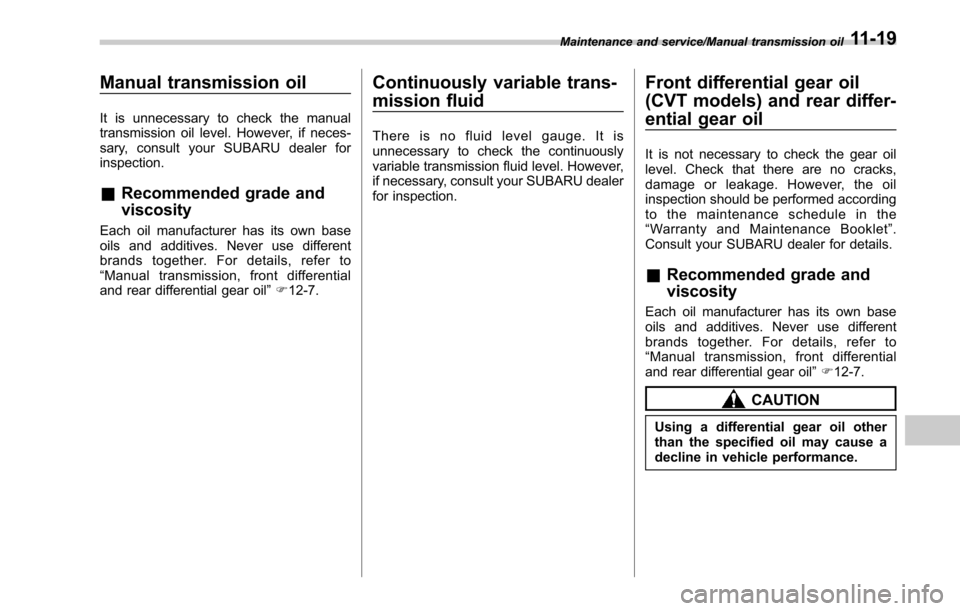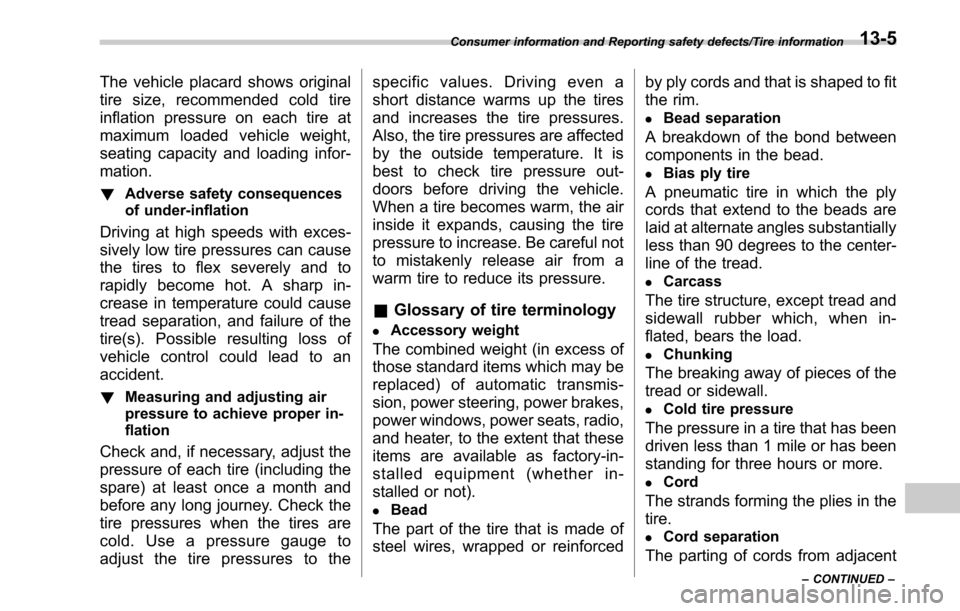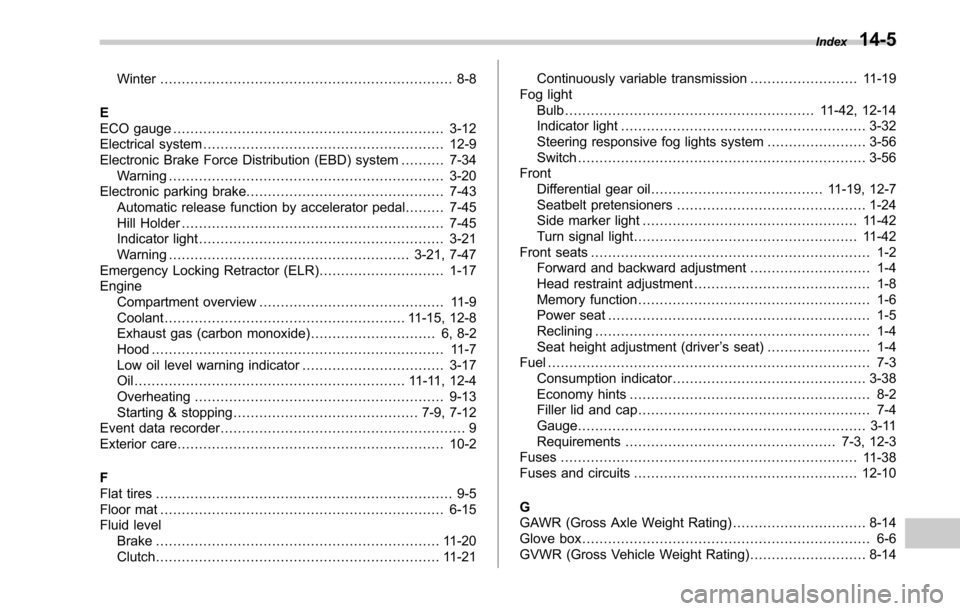2017 SUBARU LEGACY Gauge
[x] Cancel search: GaugePage 516 of 610

CAUTION
.For 2.5 L models, be careful not
to touch the engine oil filter when
removing the oil filler cap. Doing
so may result in a burn, a
pinched finger, or may cause
some other injury.
. Use only engine oil with the
recommended grade and vis-
cosity.
. Be careful not to spill engine oil
when adding it. If oil touches the
exhaust pipe, it may cause a bad
smell, smoke, and/or a fire. If
engine oil gets on the exhaust
pipe, be sure to wipe it off.
To add engine oil, remove the engine oil
filler cap and slowly pour engine oil
through the filler neck. After pouring oil
into the engine, you must use the level
gauge to confirm that the oil level is
correct.
NOTE
To prevent overfilling the engine oil, do
not add any additional oil above the full
level when the engine is cold.
& Changing the oil and oil filter
Change the oil and oil filter according to
the maintenance schedule in the “War-
ranty and Maintenance Booklet ”.
NOTE
.Changing the engine oil and oil filter
should be performed by a well-trained
expert. Contact your SUBARU dealer
for changing the engine oil and oil filter.
Fully trained mechanics are on standby
at a SUBARU dealer to utilize the
special tools, spare parts and recom-
mended oil for this work, and also,
used oils are properly disposed of.
. If performing oil replacement your-
self, observe the local regulations and
dispose of waste oil properly.
& Recommended grade and
viscosity
CAUTION
Use only engine oil with the recom-
mended grade and viscosity.
Refer to “Engine oil ”F 12-4.
NOTE
Engine oil viscosity (thickness) affects
fuel economy. Oils of lower viscosity provide better fuel economy. However,
in hot weather, oil of higher viscosity is
required to properly lubricate the en-
gine.
&
Synthetic oil
You should use synthetic engine oil that
meets the same requirements given for
conventional engine oil. When using
synthetic oil, you must use oil of the same
classification, viscosity and grade shown
in this Owner ’s Manual. Refer to “Engine
oil ”F 12-4. Also, you must follow the oil
and filter changing intervals shown in the
Warranty and Maintenance booklet.
NOTE
Synthetic oil of the grade and viscosity
noted in chapter 12 is the recom-
mended engine oil for optimum engine
performance. Conventional oil may be
used if synthetic oil is unavailable.
Maintenance and service/Engine oil11-13
Page 517 of 610

Maintenance and service/Cooling system
Cooling system
WARNING
Never attempt to remove the radia-
tor cap until the engine has been
shut off and has cooled down
completely. Since the coolant is
under pressure, you may suffer
serious burns from a spray of boil-
ing hot coolant when the cap is
removed.
CAUTION
.Vehicles are filled at the factory
with SUBARU Super Coolant that
does not require the first change
for 11 years/137,500 miles (11
years/220,000 km). This coolant
should not be mixed with any
other brand or type of coolant
during this period. Mixing with a
different coolant will reduce the
life of the coolant. Should it be
necessary to top off the coolant
for any reason, use only
SUBARU Super Coolant.
If the SUBARU Super Coolant is
diluted with another brand or type, the maintenance interval is
shortened to that of the mixing
coolant.
. Do not splash the engine coolant
over painted parts. The alcohol
contained in the engine coolant
may damage the paint surface.
& Cooling fan, hose and con-
nections
Your vehicle employs an electric cooling
fan which is thermostatically controlled to
operate when the engine coolant reaches
a specific temperature.
1) Normal operating range
If the radiator cooling fan does not operate
even when the engine coolant tempera- ture gauge exceeds the normal operating
range, the cooling fan circuit may be
defective. Refer to
“Temperature gauge ”
F 3-12.
Check the fuse and replace it if necessary.
Refer to “Fuses”F 11-38 and “Fuses and
circuits ”F 12-10. If the fuse is not blown,
have the cooling system checked by your
SUBARU dealer.
If frequent addition of coolant is neces-
sary, there may be a leak in the engine
cooling system. It is recommended that
the cooling system and connections be
checked for leaks, damage, or looseness.
11-14
Page 522 of 610

Manual transmission oil
It is unnecessary to check the manual
transmission oil level. However, if neces-
sary, consult your SUBARU dealer for
inspection.
&Recommended grade and
viscosity
Each oil manufacturer has its own base
oils and additives. Never use different
brands together. For details, refer to
“Manual transmission, front differential
and rear differential gear oil ”F 12-7.
Continuously variable trans-
mission fluid
There is no fluid level gauge. It is
unnecessary to check the continuously
variable transmission fluid level. However,
if necessary, consult your SUBARU dealer
for inspection.
Front differential gear oil
(CVT models) and rear differ-
ential gear oil
It is not necessary to check the gear oil
level. Check that there are no cracks,
damage or leakage. However, the oil
inspection should be performed according
to the maintenance schedule in the
“Warranty and Maintenance Booklet ”.
Consult your SUBARU dealer for details.
& Recommended grade and
viscosity
Each oil manufacturer has its own base
oils and additives. Never use different
brands together. For details, refer to
“Manual transmission, front differential
and rear differential gear oil ”F 12-7.
CAUTION
Using a differential gear oil other
than the specified oil may cause a
decline in vehicle performance.
Maintenance and service/Manual transmission oil11-19
Page 530 of 610

SUBARU dealer as soon as possible
for tire and sensor replacement and/
or system resetting. If the light
illuminates steadily after blinking
for approximately one minute,
promptly contact a SUBARU dealer
to have the system inspected.
&Tire inspection
Check on a daily basis that the tires are
free from serious damage, nails, and
stones. At the same time, check the tires
for abnormal wear.
Contact your SUBARU dealer immedi-
ately if you find any problem.
NOTE
. When the wheels and tires strike
curbs or are subjected to harsh treat-
ment as when the vehicle is driven on a
rough surface, they can suffer damage
that cannot be seen with the naked eye.
This type of damage does not become
evident until time has passed. Try not
to drive over curbs, potholes or on
other rough surfaces. If doing so is
unavoidable, keep the vehicle ’s speed
down to a walking pace or less, and
approach the curbs as squarely as
possible. Also, make sure the tires are
not pressed against the curb when you park the vehicle.
.
If you feel unusual vibration while
driving or find it difficult to steer the
vehicle in a straight line, one of the
tires and/or wheels may be damaged.
Drive slowly to the nearest authorized
SUBARU dealer and have the vehicle
inspected.
& Tire pressures and wear
Maintaining the correct tire pressures
helps to maximize the tires ’service lives
and is essential for good running perfor-
mance. Check and, if necessary, adjust
the pressure of each tire (including the
spare) at least once a month (for example,
during a fuel stop) and before any long
journey.
Tire placard
Check the tire pressures when the tires
are cold. Use a pressure gauge to adjust
the tire pressures to the values shown on
the tire placard. The tire placard is located
on the door pillar on the driver ’s side.
Driving even a short distance warms up
the tires and increases the tire pressures.
Also, the tire pressures are affected by the
outside temperature. It is best to check tire
pressure outdoors before driving the
vehicle.
When a tire becomes warm, the air inside
it expands, causing the tire pressure to
increase. Be careful not to mistakenly
release air from a warm tire to reduce its
pressure.
NOTE
. The air pressure in a tire increases
by approximately 4.3 psi (30 kPa, 0.3
kgf/cm
2) when the tire becomes warm.
. The tires are considered cold when
the vehicle has been parked for at least
3 hours or has been driven less than 1
mile (1.6 km).
WARNING
Do not let air out of warm tires to
adjust pressure. Doing so will result
in low tire pressure.
Maintenance and service/Tires and wheels
–CONTINUED –11-27
Page 578 of 610

The vehicle placard shows original
tire size, recommended cold tire
inflation pressure on each tire at
maximum loaded vehicle weight,
seating capacity and loading infor-
mation.
!Adverse safety consequences
of under-inflation
Driving at high speeds with exces-
sively low tire pressures can cause
the tires to flex severely and to
rapidly become hot. A sharp in-
crease in temperature could cause
tread separation, and failure of the
tire(s). Possible resulting loss of
vehicle control could lead to an
accident.
!Measuring and adjusting air
pressure to achieve proper in-
flation
Check and, if necessary, adjust the
pressure of each tire (including the
spare) at least once a month and
before any long journey. Check the
tire pressures when the tires are
cold. Use a pressure gauge to
adjust the tire pressures to the specific values. Driving even a
short distance warms up the tires
and increases the tire pressures.
Also, the tire pressures are affected
by the outside temperature. It is
best to check tire pressure out-
doors before driving the vehicle.
When a tire becomes warm, the air
inside it expands, causing the tire
pressure to increase. Be careful not
to mistakenly release air from a
warm tire to reduce its pressure.
&
Glossary of tire terminology
.Accessory weight
The combined weight (in excess of
those standard items which may be
replaced) of automatic transmis-
sion, power steering, power brakes,
power windows, power seats, radio,
and heater, to the extent that these
items are available as factory-in-
stalled equipment (whether in-
stalled or not).
.Bead
The part of the tire that is made of
steel wires, wrapped or reinforced by ply cords and that is shaped to fit
the rim.
.Bead separation
A breakdown of the bond between
components in the bead.
.Bias ply tire
A pneumatic tire in which the ply
cords that extend to the beads are
laid at alternate angles substantially
less than 90 degrees to the center-
line of the tread.
.Carcass
The tire structure, except tread and
sidewall rubber which, when in-
flated, bears the load.
.Chunking
The breaking away of pieces of the
tread or sidewall.
.Cold tire pressure
The pressure in a tire that has been
driven less than 1 mile or has been
standing for three hours or more.
.Cord
The strands forming the plies in the
tire.
.Cord separation
The parting of cords from adjacent
Consumer information and Reporting safety defects/Tire information
–CONTINUED –13-5
Page 594 of 610

Winter.................................................................... 8-8
E
ECO gauge ............................................................... 3-12
Electrical system ........................................................ 12-9
Electronic Brake Force Distribution (EBD) system .......... 7-34
Warning ................................................................ 3-20
Electronic parking brake. ............................................. 7-43
Automatic release function by accelerator pedal ......... 7-45
Hill Holder ............................................................. 7-45
Indicator light ......................................................... 3-21
Warning ........................................................ 3-21, 7-47
Emergency Locking Retractor (ELR) ............................. 1-17
Engine Compartment overview ........................................... 11-9
Coolant ........................................................ 11-15, 12-8
Exhaust gas (carbon monoxide) ............................. 6, 8-2
Hood .................................................................... 11-7
Low oil level warning indicator ................................. 3-17
Oil............................................................... 11-11, 12-4
Overheating .......................................................... 9-13
Starting & stopping ........................................... 7-9, 7-12
Event data recorder ......................................................... 9
Exterior care .............................................................. 10-2
F
Flat tires ..................................................................... 9-5
Floor mat .................................................................. 6-15
Fluid level Brake .................................................................. 11-20
Clutch .................................................................. 11-21 Continuously variable transmission
......................... 11-19
Fog light Bulb .......................................................... 11-42, 12-14
Indicator light ......................................................... 3-32
Steering responsive fog lights system ....................... 3-56
Switch ................................................................... 3-56
Front Differential gear oil ........................................ 11-19, 12-7
Seatbelt pretensioners ............................................ 1-24
Side marker light .................................................. 11-42
Turn signal light .................................................... 11-42
Front seats ................................................................. 1-2
Forward and backward adjustment ............................ 1-4
Head restraint adjustment ......................................... 1-8
Memory function ...................................................... 1-6
Power seat ............................................................. 1-5
Reclining ................................................................ 1-4
Seat height adjustment (driver ’s seat) ........................ 1-4
Fuel ........................................................................\
... 7-3
Consumption indicator ............................................. 3-38
Economy hints ........................................................ 8-2
Filler lid and cap ...................................................... 7-4
Gauge ................................................................... 3-11
Requirements ................................................. 7-3, 12-3
Fuses .....................................................................
11-38
Fuses and circuits .................................................... 12-10
G
GAWR (Gross Axle Weight Rating) .. ............................. 8-14
Glove box ................................................................... 6-6
GVWR (Gross Vehicle Weight Rating) ........................... 8-14
Index14-5
Page 597 of 610

14-8Index
Transmission......................................................... 7-23
Transmission oil ............................................ 11-19, 12-7
Map light ........................................................... 6-2, 11-48
Maximum load limits ................................................... 8-22
Meters and gauges ...................................................... 3-8
Mirror defogger .......................................................... 3-61
Mirrors ...................................................................... 3-63
Moonroof .................................................................. 2-48
Multi information display .............................................. 3-36
N
New vehicle break-in driving .......................................... 8-2
O
Odometer .................................................................... 3-9
Off road driving ............................................................ 8-6
Oil filter .................................................................... 11-13
Oil level Engine ................................................................. 11-11
Manual transmission .............................................. 11-19
Warning light ......................................................... 3-17
Oil pressure warning light ............................................ 3-16
Outside Mirror defogger ...................................................... 3-61
Mirrors .................................................................. 3-81
Temperature indicator ............................................. 3-35
Overhead console ........................................................ 6-7
Overheating engine .................................................... 9-13
P
Parking ..................................................................... 7-42 Brake
.................................................................... 7-43
Tips ...................................................................... 7-47
Periodic inspections ..................................................... 8-4
Petrol fuel ................................................................... 7-3
PIN Code Access ....................................................... 2-22
Pocket ....................................................................... 6-7
Power Door locking switch .................................................. 2-9
Outlets .................................................................. 6-10
Outside mirrors ...................................................... 3-82
Rear gate ...................................................... 2-42, 9-21
Seat ....................................................................... 1-5
Steering ................................................................ 7-31
Steering warning light .............................................. 3-23
Windows ............................................................... 2-34
Precautions against vehicle modification ................ 1-27, 1-70
Preparing to drive ........................................................ 7-8
Push-button Ignition switch ......................................................... 3-6
Starting and stopping engine .................................... 7-12
R
RAB (Reverse Automatic Braking) OFF indicator ......................................................... 3-33
ON/OFF setting ...................................................... 7-69
Warning indicator .................................................... 3-33
RCTA........................................................................\
7-55
Rear Combination lights ................................................ 11-44
Differential gear oil ........................................ 11-19, 12-7
Gate .....................................................................
2-41
Page 599 of 610

14-10Index
Heater.................................................................... 1-9
Height adjustment .................................................... 1-4
Memory function ...................................................... 1-6
Power ..................................................................... 1-5
Rear ..................................................................... 1-11
Seatbelt ................................................................. 4, 1-16
Fastening .............................................................. 1-17
Maintenance .......................................................... 1-24
Pretensioners ........................................................ 1-24
Safety tips ............................................................. 1-16
Warning light and chime ......................................... 3-13
Security Alarm system ........................................................ 2-28
Immobilizer. ............................................................. 2-4
Indicator light ......................................................... 3-30
Shock sensors ....................................................... 2-33
Select lever Position indicator ................................................... 3-31
Shift lock function ................................................... 7-28
Shock sensors ........................................................... 2-33
Shopping bag hook .................................................... 6-13
Snow tires ........................................................ 8-11, 11-25
Snowy and icy roads .................................................. 8-10
Spark plugs ...................................................... 11-18, 12-9
Specifications ............................................................ 12-2
Speedometer ............................................................... 3-9
SRS airbag (Supplemental Restraint System airbag) ... 4, 1-41
SRS airbag system Monitors. ............................................................... 1-68
Servicing ............................................................... 1-69
Warning light ......................................................... 3-15 Starting & stopping engine
.................................... 7-9, 7-12
State emission testing (U.S. only) .................................. 7-7
Steering responsive fog lights system ... ........................ 3-56
OFF indicator ......................................................... 3-32
Steering switches for audio .......................................... 5-63
Steering wheel Lock ............................................................. 7-11, 7-14
Power ................................................................... 7-31
Tilt/telescopic ......................................................... 3-82
Stop light ................................................................. 12-15
Storage compartment ................................................... 6-6
Sun shade ................................................................. 2-50
Sun visors .................................................................. 6-4
Supplemental Restraint System airbag (SRS) ................ 1-41
Synthetic leather upholstery ......................................... 10-6
T
Tachometer ................................................................ 3-10
Temperature gauge ..................................................... 3-12
Temperature warning light AT OIL TEMP ......................................................... 3-17
Temporary spare tire .................................................... 9-2
Tether (child restraint system) .............................. 1-36, 1-39
Tie-down hooks .......................................................... 9-14
Tire................................................................. 11-25, 12-9 Chains ..................................................................
8-12
Inspection ............................................................ 11-27
Pressures and wear .............................................. 11-27
Replacement. ....................................................... 11-30
Rotation .............................................................. 11-30
Size and pressure .................................................. 12-9